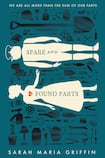
“Computers ruptured how people speak to one another; they tore away the stitching of how our society works. Whole towns of people didn’t speak a word aloud for years before the Turn, so greedy for information, for the silent sanctuary of their digital world.”
Like all good science fiction, Spare and Found Parts makes an observation about society today and takes it to an extreme. Set 100 years after "the Turn", a machine generated epidemic that wiped out most of Ireland, the 10,000 or so survivors live in a computer-free world known as Black Water City.
It is a vivid and deftly created near-future Ireland where memories of the old country pepper the narrative. “The Needle” stands tall in the centre of the city. The Lighthouse is the latest in post-apocalyptic bars. Maud Gonne Hospital is a Gothic mecca of spare body parts. Kathleen Ní Houlihan is a 600ft stone statue that simultaneously watches over and dwarfs the city’s inhabitants.
For the novel’s protagonist Nell Crane, a misanthropic teenager neglected by her inventor parents, the statue is a symbol of her impotence. Her mother Cora designed the megalith before her death, enshrining her in the city’s collective memory. Nell’s father is Marvellous Doctor Julian, a Frankenstein-esque inventor who has a lengthy waiting list of survivors looking to be whole again.
Something missing
Harking to the title, the inhabitants of Black Water City (with its Burning Man overtones) each have their own specific injury. Missing arms, legs, eyes – and uniquely in Nell’s case, a heart – are the price paid for surviving the Turn. Those who await one of Julian’s prosthetics live in the Pale. Those who are whole again get to move to the green fields and earthly delights of the Pasture.
Sarah Maria Griffin’s debut for the young adult market gives its readers plenty in the way of imaginative settings and scenarios. Each of the city’s inhabitants is charged with coming up with a stomach-churning “contribution” that will go down in history as their legacy to the community. The plot revolves around Nell’s effort to make something that will set her apart from her superstar parents. Letters from her grandmother Nan out on the Pasture seek to intensify the pressure. They intrigue at the beginning but get lost amid the numerous plot threads of back-stabbing, family secrets and a computer robot friendship.
Pacing is an issue, with major scenes – a break-in at the hospital, the discovery of Nell’s mother’s body, the arrival of Nan and subsequent climax with Julian at the family home – lacking tension. Big bangs are over before readers have time to digest their meaning. It is a shame, in a book that offers plenty for young adult readers to think about.
Gothic
This is Griffin’s first YA offering but time spent living abroad in San Francisco resulted in a well-received memoir, Not Lost, published by New Island in 2013. Her eloquent and evocative writing is put to good use in her fiction as she creates a convincingly Gothic world of body parts dredged up in seawater and unearthed in morgues.
Griffin’s way with colour charms from the outset, with Nell memorably describing the loss of her mother in the prologue: “And you’re out into the hallway, down the stairs in his arms, floods of tears, green still at the corner of your vision. Green like the parklands, green like poison. Like electricity.”
Nell is a well-drawn character, prickly and pragmatic while trying to survive in a world without sanctuary. Her best friend Ruby is equally vibrant: “She was a round, bright pinwheel in the water, and Nell was drawn out like her long shadow on the land.” A questionable love interest, Oliver Kelly, will keep readers guessing as to the motives for his unending pursuit of Nell.
The themes of the book also interest, with the information overload storyline recalling the Chaos Walking series by Patrick Ness. Creation is a major focus. Marvellous Julian is deified for his ability to fashion limbs from scraps. His protégé Oliver yearns to have the same spark of genius but admits he is only a craftsman.
As Nell decides to build a new friend for herself through computer contraband – the lovable IO, whose voice brings lightness to the second part of the book and deserves more prominence – she wonders: “What could be more human than building something new, more human than making life?” External pressure on the artist’s process manifests in that most annoying of questions: “Girl, you got anything exciting in the works?”
There are also the enticing possibilities of re-creation. “Tell me the shape you want to be,” Ruby says to Nell as she sets about redrawing her. It is yet another interesting premise in a book that doesn’t quite find itself by the closing. As per the title, it is in the parts rather than the whole that readers will find the jewels.















